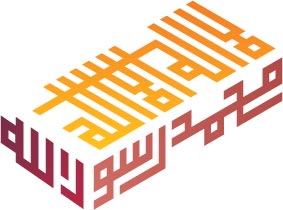ARABIC CALLIGRAPHY INSTRUCTION
![]()
ARABIC CALLIGRAPHY INSTRUCTION
Cubic Kufi Designs
Instructor: Mamoun Sakkal
|
Analysis of Cubic Kufi in "Steps and Shadows" When Square Kufi is written on more than one plane in space, the result can be described as "Cubic Kufi" because we move the calligraphy from the two dimensional sphere (square) to the three dimensional sphere (cube). In the history of Islamic calligraphy, one can find examples of Square Kufi where the angles are 30/60 degrees rather than the common 90 degrees. In such examples, the calligraphy gives the illusion of perspective and appears to be written on different planes. Mamoun Sakkal took this concept a step further by giving the lines of calligraphy a depth in the third dimension, and turned the calligraphy into a complete 3D object. One of his earliest works in this style is a design for a monument in 1975 based on Eastern Kufi. A later example is Steps and Shadows which is based on Square Kufi. The design process for this work is presented here. 1. Original line of Square Kufi calligraphy. This is a simple design for Shahada, the proclamation of faith in Islam: La ilaha illa Allah, Muhammadun rasulul Allah (There is no Deity but God, Muhammad is the messenger of God). 2. Division of the calligraphy line to three sections that correspond with the three planes of space. 3. Adjustment of calligraphy to allow for continuation of forms from one plane to another. 4. The final design of Shahada with shading and lighting. Although it is possible to create this image using a 3D modeling program, in this case the artist rendered it using FreeHand, a 2D illustration program. 5. This design is repeated to make up the complete piece or artwork, Steps and Shadows. |
1. |
|
2. |
|
|
3.
 |
|
|
4. |
| Calligraphy Instruction | Arabic Calligraphy | Sakkal Home |